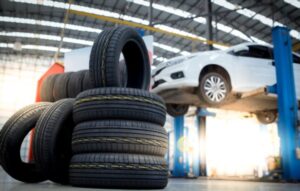When it comes to tires, one size does not fit all. Just like there are different types of vehicles designed for specific purposes, there are different tire categories tailored to meet specific needs. One such category is XL tires. XL stands for “Extra Load” and, as the name suggests, these tires are designed to support heavier loads than their standard counterparts. In this guide, we’ll explore the benefits of XL tires, when you should consider upgrading to them, and how to select the right ones for your vehicle.
Although XL tires may look similar to standard tires, they feature a more robust construction, allowing them to carry heavier loads. They achieve this through reinforced sidewalls and a higher load index, which is a numerical value that indicates the maximum weight a tire can support when properly inflated. While standard tires are suitable for most everyday driving situations, XL tires excel in more demanding scenarios where additional load support is crucial.
Benefits of XL Tires
Enhanced Load Carrying Capacity
One of the primary advantages of XL tires is their ability to support heavier loads. If you frequently transport heavy cargo or drive a vehicle with a high curb weight, XL tires can provide the extra load support needed to maintain vehicle stability and handling. This enhanced carrying capacity can also be beneficial for drivers who tow trailers or campers, as well as those who drive commercial vehicles.
Improved Handling and Stability
XL tires offer improved handling and stability, thanks to their reinforced sidewalls. The stiffer construction helps to reduce sidewall flex, providing a more responsive and controlled driving experience. This can be especially beneficial in high-performance driving situations, such as on twisty roads or during high-speed maneuvers, where precise handling is essential.
Greater Puncture Resistance
The more robust construction of XL tires means they are less prone to punctures and damage caused by road debris or rough terrain. This can be a valuable feature for those who frequently drive off-road or in areas with poor road conditions. Additionally, the thicker sidewalls provide increased protection against impacts, such as hitting a curb or pothole, further reducing the risk of damage.
Better Traction in Challenging Conditions
XL tires are often designed with more aggressive tread patterns, providing improved traction in challenging conditions such as mud, snow, and sand. This makes them an ideal choice for drivers who regularly encounter off-road or extreme weather situations. The enhanced grip can also benefit high-performance vehicles, which require better traction for optimal acceleration and cornering.
When to Consider Upgrading to XL Tires
Frequent Heavy Load Transportation
If you regularly transport heavy cargo, such as construction materials or equipment, upgrading to XL tires can provide the additional load support necessary to ensure your vehicle remains stable and safe on the road. This is especially important for commercial vehicles, which often carry heavy loads over long distances.
Off-Road Adventures
For those who love off-road adventures, XL tires are a must-have. Their increased puncture resistance and better traction make them ideal for navigating rough terrain, while their enhanced load capacity ensures that your vehicle can handle the additional weight of off-road gear and equipment.
Towing or Hauling
Towing a trailer or hauling a camper requires additional load support, and XL tires are designed to meet this demand. Their increased load capacity and improved handling characteristics make them a top choice for drivers who need to tow or haul heavy loads on a regular basis.
High-Performance Driving
High-performance vehicles demand tires that can keep up with their capabilities, and XL tires are up to the task. Their stiffer construction provides improved handling and stability, while their aggressive tread patterns offer better traction for superior acceleration and cornering.
Selecting the Right XL Tires for Your Vehicle
Determining the Correct Load Index
When choosing XL tires, it’s essential to select the right load index for your vehicle. The load index is a numerical value that indicates the maximum weight a tire can support when properly inflated. You can find the recommended load index for your vehicle in the owner’s manual or on the tire placard, which is usually located on the driver’s side door jamb. Be sure to choose XL tires with a load index equal to or greater than the recommended value.
Choosing the Right Tire Type
XL tires are available in various types, such as all-season, summer, winter, and all-terrain. Consider your driving habits and the conditions you most frequently encounter to determine the most suitable tire type. For example, if you live in an area with harsh winters, you may want to consider XL winter tires for enhanced traction on snow and ice.
Selecting the Right Size and Fitment
In addition to the load index and tire type, you’ll also need to choose the correct size and fitment for your vehicle. This information can be found in your owner’s manual or on the tire placard. Keep in mind that upsizing to a larger tire may require additional modifications to your vehicle, such as adjusting the suspension or installing fender flares.
XL Tires and Fuel Efficiency: What to Expect
Factors Affecting Fuel Efficiency
While XL tires offer numerous benefits, it’s important to be aware that they can also affect your vehicle’s fuel efficiency. The heavier construction and increased rolling resistance may result in slightly lower fuel economy compared to standard tires. However, this difference is often minimal and can be offset by adopting fuel-saving driving habits and maintaining proper tire inflation.
Tips for Maximizing Fuel Efficiency with XL Tires
To get the most out of your XL tires without sacrificing fuel efficiency, follow these tips:
- Keep your tires properly inflated: Regularly check and maintain the recommended tire pressure to ensure optimal fuel economy.
- Rotate your tires: Regular tire rotations help promote even wear and prolong tire life, which can contribute to improved fuel efficiency.
- Avoid aggressive driving: Sudden acceleration and hard braking can increase fuel consumption. Adopt a smooth, steady driving style to conserve fuel.
Maintaining Your XL Tires
Proper Inflation and Pressure Checks
Maintaining the correct tire pressure is crucial for the performance and longevity of your XL tires. Check your tire pressure at least once a month and before long trips, and adjust it according to the manufacturer’s recommendations. Properly inflated tires not only improve fuel efficiency but also ensure optimal handling, stability, and tire wear.
Regular Tire Rotations
To maximize the lifespan of your XL tires and promote even wear, it’s essential to rotate them regularly. Most manufacturers recommend rotating tires every 5,000 to 8,000 miles or as specified in your vehicle’s owner’s manual. Regular tire rotations can also help maintain balanced handling and improve overall vehicle performance.
Balancing and Alignment
Balancing your tires and maintaining proper wheel alignment are essential aspects of tire maintenance. Unbalanced tires can cause uneven wear, vibrations, and reduced fuel efficiency, while poor alignment can result in handling issues and accelerated tire wear. Be sure to have your tires balanced and wheels aligned according to the manufacturer’s recommendations.
Inspecting for Wear and Damage
Inspect your XL tires regularly for signs of wear or damage, such as cuts, punctures, or uneven tread wear. Addressing any issues promptly can help prevent more severe problems and prolong the life of your tires. Be sure to replace your tires when the tread depth reaches the minimum legal limit or if the tires show signs of aging, such as cracking or sidewall bulging.
Top XL Tire Brands and Recommendations
When selecting XL tires, it’s essential to choose a reliable and reputable brand. Here are some of the top XL tire brands and their highly-rated products:
- Michelin: Michelin offers a range of high-quality XL tires, such as the Michelin Defender LTX M/S, which is known for its excellent all-season performance and durability.
- Goodyear: Goodyear’s XL tire lineup includes the popular Goodyear Wrangler DuraTrac, an all-terrain tire designed for exceptional off-road traction and on-road handling.
- Bridgestone: The Bridgestone Dueler H/L Alenza Plus is an XL tire that provides a comfortable ride, long wear life, and all-season performance for SUVs and light trucks.
- Pirelli: Pirelli’s Scorpion Verde All-Season Plus II is an eco-friendly XL tire designed for SUVs and crossovers, offering a comfortable ride, low rolling resistance, and excellent wet and dry handling.
- Continental: The Continental TerrainContact A/T is an all-terrain XL tire that delivers a quiet, comfortable ride on the highway while providing excellent off-road performance and durability.
Frequently Asked Questions about XL Tires
Can I mix XL Tires with Standard Tires?
It’s not recommended to mix XL tires with standard tires, as it can lead to uneven handling and potential safety issues. Always install the same type of tire on all four wheels to ensure balanced performance and vehicle stability.
Do XL Tires have a harsher ride?
XL tires may have a slightly stiffer ride compared to standard tires due to their reinforced sidewalls. However, this difference is usually minimal and may not be noticeable in most driving situations. If ride comfort is a priority, consider choosing XL tires with a higher speed rating, as they generally offer a more comfortable ride.
Can all vehicles use XL Tires?
Not all vehicles are compatible with XL tires. Always consult your owner’s manual or a professional tire dealer to determine if your vehicle can accommodate XL tires. Upgrading to XL tires may require modifications to your vehicle’s suspension or other components to ensure proper fitment and performance.
Are XL Tires more expensive than Standard Tires?
XL tires may be slightly more expensive than their standard counterparts due to their more robust construction and enhanced performance characteristics. However, the additional cost can be offset by the benefits of improved handling, durability, and load-carrying capacity.
Conclusion: Are XL Tires Right for You?
XL tires offer a range of benefits, including enhanced load capacity, improved handling, and better traction in challenging conditions. However, they may not be the best choice for everyone. Carefully consider your driving habits, vehicle requirements, and the specific advantages of XL tires before deciding if they are right for you. By selecting the appropriate XL tires for your needs and maintaining them properly, you can enjoy the benefits of improved performance, safety, and durability.


